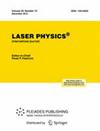低功率红色激光和蓝色LED对人乳腺癌细胞中昼夜节律基因mRNA水平的影响
IF 1.1
4区 物理与天体物理
Q4 OPTICS
引用次数: 0
摘要
摘要低功率蓝光二极管(LED)和红光激光已被用于光生物调节(PBM)的治疗方案。这种效应是在光感受器吸收辐射后触发的,从而导致分子、细胞和全身反应。隐色素参与昼夜周期控制,与肿瘤的发生发展有关。尽管这些蛋白质能够吸收紫蓝色的光,但关于它们参与PBM的数据很少。因此,本研究旨在评估低功率蓝色LED (470 nm)和红色激光(658nm)辐射对隐色素基因mRNA水平的影响,以及参与人类乳腺癌细胞中隐色素基因调控的mRNA水平。将MCF-7和MDA-MB-231细胞分别暴露于低功率蓝色LED (470 nm, 640 J cm−2)和红色激光(660 nm, 9 J cm−2)下,通过逆转录-定量聚合酶链反应检测CRY1、CRY2、PER2、BMAL1和CLOCK基因的相对mRNA水平。结果表明,暴露在低功率蓝色LED和红色激光下,不会改变MCF-7和MDA-MB-231人类乳腺癌细胞中隐色素基因的mRNA水平,以及参与其调控的mRNA水平。本文章由计算机程序翻译,如有差异,请以英文原文为准。
Low-power red laser and blue LED on circadian gene mRNA levels in human breast cancer cells
Abstract Low-power blue light-emitting diode (LED) and red laser have been used for therapeutic proposals based on photobiomodulation (PBM). This effect is trigged after absorption of radiation by photoacceptors, which lead to molecular, cellular and systemic responses. Cryptochromes are involved in circadian cycle control, and associated with development and progression of tumors. Despite such proteins are able to absorb violet-blue lights, there are few data on their participation in PBM. Thus, this work aims to evaluate the effects of radiations emitted by low-power blue LED (470 nm) and red laser (658 nm) on mRNA levels from cryptochromes genes as well as those from involved in their regulation in human breast cancer cells. The MCF-7 and MDA-MB-231 cells were exposed to low-power blue LED (470 nm, 640 J cm −2 ) and red laser (660 nm, 9 J cm −2 ), and relative mRNA levels from CRY1, CRY2, PER2, BMAL1 and CLOCK genes were evaluated by reverse transcription-quantitative polymerase chain reaction. The results suggested that exposure to low-power blue LED and red laser do not alter the mRNA levels from cryptochromes genes, and those involved in their regulation, in MCF-7 and MDA-MB-231 human breast cancer cells.
求助全文
通过发布文献求助,成功后即可免费获取论文全文。
去求助
来源期刊

Laser Physics
物理-光学
CiteScore
2.60
自引率
8.30%
发文量
127
审稿时长
2.2 months
期刊介绍:
Laser Physics offers a comprehensive view of theoretical and experimental laser research and applications. Articles cover every aspect of modern laser physics and quantum electronics, emphasizing physical effects in various media (solid, gaseous, liquid) leading to the generation of laser radiation; peculiarities of propagation of laser radiation; problems involving impact of laser radiation on various substances and the emerging physical effects, including coherent ones; the applied use of lasers and laser spectroscopy; the processing and storage of information; and more.
The full list of subject areas covered is as follows:
-physics of lasers-
fibre optics and fibre lasers-
quantum optics and quantum information science-
ultrafast optics and strong-field physics-
nonlinear optics-
physics of cold trapped atoms-
laser methods in chemistry, biology, medicine and ecology-
laser spectroscopy-
novel laser materials and lasers-
optics of nanomaterials-
interaction of laser radiation with matter-
laser interaction with solids-
photonics
 求助内容:
求助内容: 应助结果提醒方式:
应助结果提醒方式:


